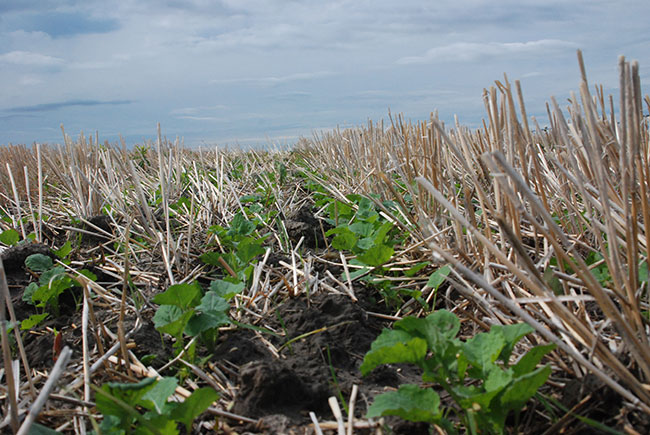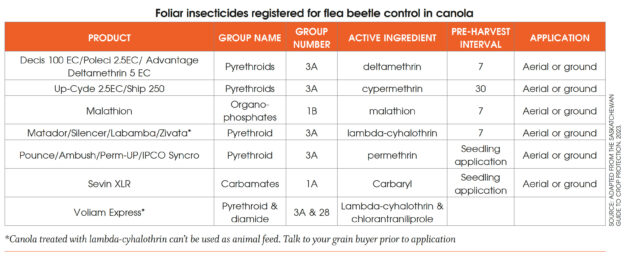
Features
Insect Pests
Revisiting flea beetle control
They never seem to go away.
January 3, 2024 By Bruce Barker
 Insecticidal seed treatments can last three to four weeks from seeding date.
Photo by bruce barker.
Insecticidal seed treatments can last three to four weeks from seeding date.
Photo by bruce barker. Despite the best efforts of canola growers, researchers and the industry, flea beetles continue to cause problems almost every year in Western Canada. Even when protected by insecticidal seed treatments, research has found that yield loss under heavy feeding pressure can cause up to a 10 per cent yield loss.
“Flea beetle pressure was still quite high in canola in 2023, but overall damage from flea beetles and the amount of foliar applications of insecticides for flea beetles were less than in the past few years,” says John Gavloski, provincial entomologist with Manitoba Agriculture at Carman, Man. “In many areas, the canola was able to germinate and grow through the seedling stages quickly, which reduces the risk of damage from flea beetles.”
The two main flea beetle species causing economic damage are the striped and crucifer flea beetles, with the hop flea beetle of minor concern. Traditionally, crucifer flea beetles have been more common in the southern Prairies and striped more common in the north. But recently, the striped flea beetle has become more common in central Alberta, central Saskatchewan and most of Manitoba.
“Levels of crucifer and striped flea beetles have been chronically high for a number of years. These species are well adapted to our Prairie climate, and although there are some natural enemies, the level of control by predators and parasitoids is often not as high as we see with some other insect pests,” says Gavloski.
Flea beetles overwinter as adults in leaf litter and debris and become active when the weather begins to warm up in the spring. Striped flea beetles emerge one to four weeks ahead of crucifer flea beetles. Crucifer flea beetle emergence peaks when ground temperature reaches 15°C. When air temperatures reach 14°C, flea beetles fly to disperse throughout a canola field.
During late spring and early summer, eggs are laid in the soil, hatch into larvae that feed on canola roots, then become pupae, and then adults emerge in late summer to overwinter and complete the life cycle. The larval stage lasts 25 to 34 days, and the pupal stage lasts about seven to nine days.
Seed treatments are the foundation of flea beetle management
Gavloski says the most damage to canola happens when heavy infestations feed on very young canola seedlings. He says research has found that yield was reduced the most when plants were damaged during the seedling to second true leaf stage, but was not reduced when they were damaged after reaching the third to fourth true leaf stage.
An insecticidal seed treatment has become the most important management tool for canola growers to reduce the impact of feeding on early leaf stages. Neonicotinoids have been the most common seed treatment, with several other groups of insecticides also becoming more commonly used, but currently they are only sold combined with a neonicotinoid.
Gavloski says research by Janet Knodel at North Dakota State University found that Helix XTra and Prosper 400 provided about three weeks of residual protection from feeding from planting date, not emergence. If weather conditions were not conducive for flea beetle feeding, the protection might extend to four weeks. The lower rate of Helix had less than three weeks of residual protection.
“The challenge is to get the canola plants to the three to four leaf stage where they can tolerate flea beetle feeding without having significant feeding injury,” says Gavloski. “Slow emergence and slow early season growth makes canola more vulnerable to flea beetles.”
An Alberta research study found that neonicotinoid seed treatments were more effective and caused greater mortality on crucifer flea beetles than striped flea beetles. This led to speculation that striped flea beetles could be developing resistance to neonicotinoid seed treatments, although whether this was insecticide resistance (where a genetic change was selected for and became dominant due to insecticide use) was not what was tested or shown.
A study led by Dr. Boyd Mori and postdoctoral fellow Priyanka Mittapelly at the University of Alberta is looking into that speculation, and have not found any detectable resistance in flea beetles that feed on canola in 2022.

Foliar management options
When environmental conditions result in slow-growing canola and favourable conditions for flea beetle feeding, economic damage can occur, and a foliar insecticidal spray may be necessary. Canola seedlings can survive 50 per cent leaf loss without a significant yield loss, but the action threshold for insecticidal control has been established when 25 per cent of leaf surface is destroyed and flea beetles are present and continuing to feed. This is based on research that found canola with up to 25 per cent leaf area loss can yield the same as canola with no leaf area loss.
“Stresses that slow canola growth in the seedling stage put canola at increased risk of needing foliar insecticides,” says Gavloski. He says the weather forecast for the upcoming days can affect the intensity of flea beetle feeding, seedling growth and the performance of insecticides, and should all be considered when making spray decisions.
Estimating the percentage defoliation can be difficult, and it is easy to overestimate the level of defoliation, as our eyes are drawn to the injured areas. The Canola Council of Canada has a graphic that shows flea beetle feeding on a leaf at 10, 20, 25, 35, and 50 per cent leaf damage.
Scout a field at five random points in a ‘W’ pattern and check 10 plants at each point. Average those results. If the action threshold is reached, there are several insecticides registered for foliar application.
Gavloski cautions that insecticides containing the active ingredient lambda-cyhalothrin were re-evaluated by the Pest Management Regulatory Agency (PMRA). Effective April 29, 2023, sunflowers, pasture, mustard seed (condiment type) and some vegetable crops were removed from the labels and are no longer registered for use in these crops. Additional, for many remaining registered crops, including canola, oilseed mustard, corn and flax, the products are still registered for use, but the crop can’t be used as animal feed.
“This means that after canola is crushed for the oil, the meal can’t be used as livestock feed. Although some formulations of lambda-cyhalothrin are available in the Canadian Prairies, it is highly advised to consider consulting the anticipated buyer of the canola prior to using a lambda-cyhalothrin insecticide, or use another product,” cautions Gavloski.
Foliar insecticides control flea beetles either on contact or by ingestion of treated leaves. The length of residual on the leaves depends on the volatility of the product, photo degradation and temperature. Some insecticides do not adsorb strongly to vegetation, says Gavloski, so volatilization can be high.
For pyrethroids, some are more toxic at lower than higher temperatures. Generally, it is best to avoid the application of pyrethroids when temperatures get into the high 20s.
The resistance study by Mori at the University of Alberta is also looking into foliar deltamethrin resistance. Results from 2022 do not appear to show any resistance. Testing is ongoing.

Cultural control strategies
The research on seeding date and flea beetle damage varies by region. In Manitoba, early seeding resulted in more flea beetle damage. In Alberta, early seeding reduced damage by flea beetles in southern Alberta, but central and northern Alberta regions had increased feeding damage. The differences are related to when the flea beetles and canola seedlings emerge. What may be the important factor in reducing the risk of damage from flea beetles is seeding under conditions most likely to result in quick germination and rapid seedling growth.
A higher seeding rate can also help reduce the feeding damage per plant because there are more plants per unit area. Seeding at 8.9 pounds per acre (10 kg/ha) had lower feeding damage per plant than seeding at 4.5 or 6.7 lbs/ac (five to 7.5 kg/ha). However, seed costs and the possibility of increased lodging may offset this advantage.
Reduced tillage creates a less favourable environment for flea beetles. The micro-environment in standing stubble is cooler, moister and less favourable for flea beetles. In Alberta, research by Lloyd Dosdall at the University of Alberta found that zero till canola could reduce flea beetle damage to levels equivalent to those found with the use of insecticidal seed treatments. However, given that much of the canola crop is now sown with reduced or no-till systems, flea beetle pressure continues to cause issues, and no-till on its own isn’t a solution.
Overall, Gavloski says the yearly challenge is to get canola to the three to four leaf stage in three to four weeks so that seed treatments can minimize flea beetle feeding. But in some years, environmental factors that delay germination and slow early season growth may increase the risk of flea beetle feeding and require a foliar insecticidal spray.